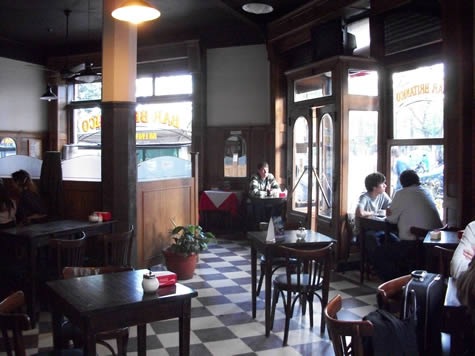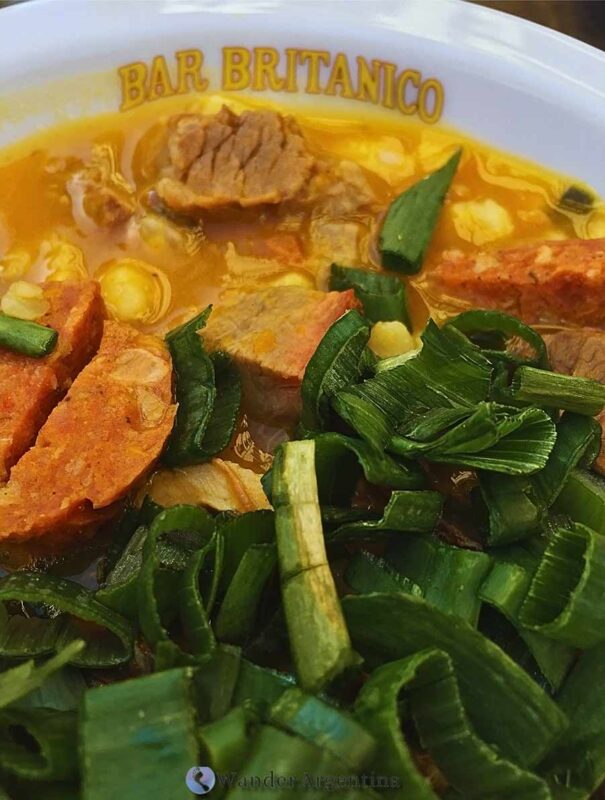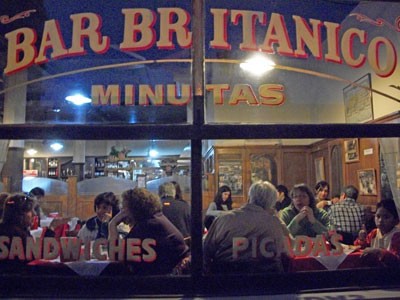Among the mythical dive bars of Buenos Aires is San Telmo’s enduring Bar Británico.

The corner bar facing Parque Lezama first opened in 1928 as ‘La Cosechera’ (The Harvester).
From the beginning, it was a gathering place for English World War I veterans and railroad workers who lived in the area.
It wasn’t long before ‘Bar Británico’ became an obvious name for this Anglo-Saxon meeting place and in the 1930’s the name was changed to reflect the predominant clientele of the era.
The ‘Tres Gallegos’
Bar Británico really earned its reputation as the iconic corner cafe of Parque Lezama beginning in 1959 when it was taken over by three Galician immigrants, Pepe Miñones, José Trillo and Manolo Pose.
The three humorous Gallegos as they were collectively called, would remain for the next four and a half decades.
From the beginning, the three cultivated an atmosphere welcoming writers looking for a place to scribble and smoke for hours on end and intellectuals who played epic games of chess.
Writer, Ernesto Sábato was said to write part of his 1961 novel, ‘Sobre Héroes y Tumbas’ (‘On Heroes and Tombs’) at his pocked wood table by the window.
Britanico During the War
During the Malvinas/Falkland War, the first three letters of the bar’s name were camouflaged to alter the name to the much less controversial — if nonsensical — ‘Bar Tánico.’
The sign stayed that way for years until the anti-English sentiment faded and the three letters were once again uncovered on the awning outside.
In 1998 Británico was one of the first bars elected for its cultural significance as a ‘notable bar’ by the Buenos Aires’ city government.
The Eviction of the Gallegos
In 2006 the existence of Bar Británico was threatened, stirring up a controversy of typical porteño proportion.
The three Galicians were evicted after the owner of the building died and his son, Juan Pablo Benvenuto, decided the place could be fixed up to fetch a higher rent.
The community was outraged –- the Galicians had rented the bar from the same family for decades without a formal contract –- but it was true that the bar hadn’t been reformed since the 1950s.
The floor was missing tiles, the bathrooms were a disaster, and decades’ worth of dust covered the copious amount of knick-knacks around the bar.
Neighbors held protests, collected signatures, and started protest blogs and Facebook groups to save the bar and the livelihood of the three Galicians who had watched many of them grow up.
Enough signatures were collected that the city’s Culture Secretary intervened to see if the building’s owner could come to an agreement with Miñones, Trillo and Pose.
The three, at this point elderly gentlemen who shuffled across the floor to take orders thanks only to the force of will, said that if they had to go they at least wanted to pass the bar on to people within their inner circle, including one waiter who had worked there for 25 years.
Thanks to the building’s listing as one of the city’s ‘historic heritage sites’ and the cafe’s ‘bar notable’ status the owner was impeded from changing the character of the interior, but the three Spaniards had no legal recourse to remain as the bar’s owner-operators and were forced to retire.
The Bar Británico of Today

Six months after the ousting of the Galicians, Bar Británico was reopened under new management, who purchased the rights to continue using the same name.
You can still sit at a sidewalk table and watch the people coming and going from Parque Lezama, or park at a window seat and nurture Porteño neurosis with one coffee after another.
Long-time waitress Julia will probably be your moza during the day — her ability to cover all the tables inside and outside is as quick as her wit.
The menu is as uninventive as ever but the dishes are well-prepared Argentine standards.
On patriotic national holidays Bar Britanico comes through with patriotic foods such as locro and pastelitos.
They even have ‘fish and chips,’ made with hake in Argentina instead of cod.
Británico’s new owner, Agustín Souza refurbished the original wood bar, replaced the pipes, redid the electricity lines and repaired the classic black and white floor tiles.
The coffee is the same –- Souza buys the same brand as the former owners.
The prices are certainly higher, but there’s no telling if that’s solely due to wacky inflation or a concerted effort to capitalize on the foreign tourists coming by to see one of the locations for the film ‘The Motorcycle Diaries’ and get a whiff the Buenos Aires’ yesteryear.
Some neighbors still maintain the attitude of scorned lovers toward Británico — they say it was once ‘their place’ and now they don’t belong — the grumpy decrepit charm is gone, and they can’t even stop by to use the bathroom like they always did and without the grandfatherly Galicians, the very soul of Británico has been sucked away.
Sentimentality aside, Británico lives on, and former customers can hope that after 45 years of tending bar, the Tres Gallegos are enjoying their involuntary retirement.
Souza, an inexperienced bar owner, concedes that he has very big shoes to fill.
“It is a lot of work. There were three of them and I’m only one person,” he says.
He initially kept the bar open 24 hours a day, save Tuesday mornings, restoring Brtitánico’s former reputation as the night owl’s old San Telmo standby.
Today it usually closes in the early morning, around 3:00 a.m.
“ We don’t have as much business at night but there is a steady stream of people — there are journalists, painters, and taxi drivers — pretty much people from all walks of life.”
⇒ Ask us about a Tour of Buenos Aires’ most historic cafes
Bar Británico-$$
Brasil 399 (corner of Defensa)
San Telmo
Tel: 4361-2107
• Hours: 7:00 a.m.— 3:00 a.m.
• Cash only

